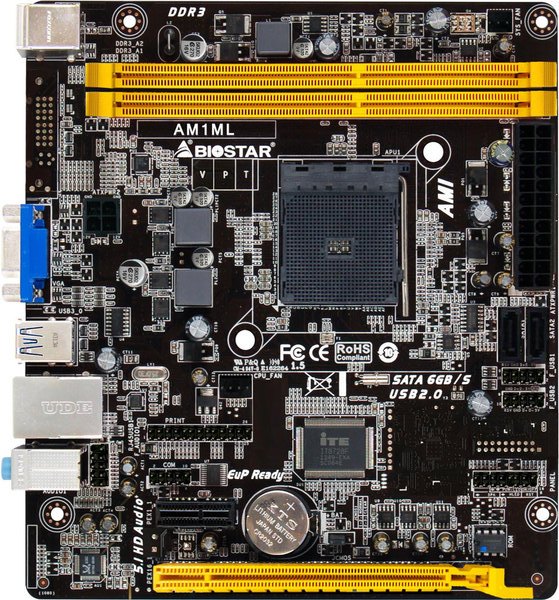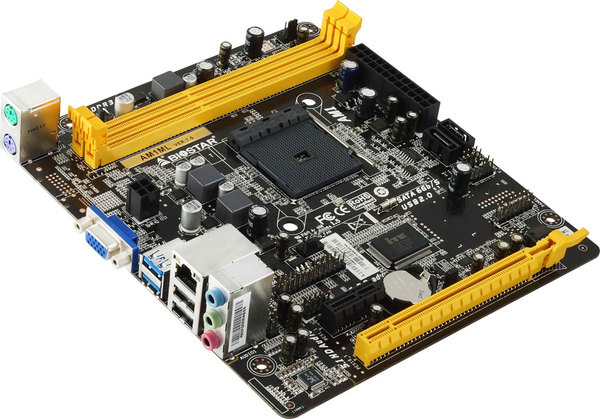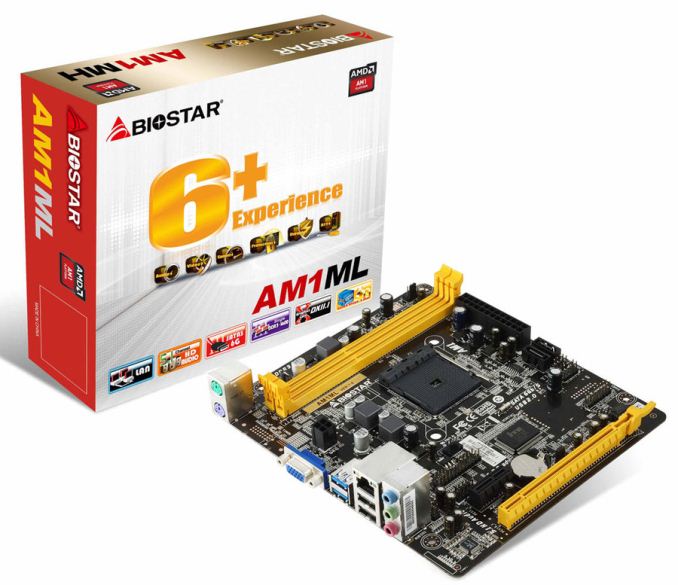The AM1 Kabini Motherboard Preview: Analyzing the Hardware
by Ian Cutress on April 19, 2014 2:00 PM ESTBiostar AM1ML
Every so often at AnandTech we review a Biostar motherboard, and sometimes we get some exciting features (the first manufacturer to test fan profiles in the BIOS) but they mostly end up as a budget play in a market with plenty of players. As part of the AM1 release Biostar hase two motherboards on sale, the cheapest of which is this AM1ML coming in at $33.
Straight off the bat the AM1ML does a couple of things differently compared to a regular motherboard:
First thing I noticed was the arrangement of the DRAM slots. Horizontal placement on a small form factor motherboard has been attempted by ASRock in the past on their channel range, but this type of arrangement is usually restricted to server type builds.
Second was the motherboard size. In my mind I immediately said mini-ITX, however on closer inspection this motherboard is essentially a mini-ITX ‘plus’. It contains the standard 17cm x 17cm layout of a mini-ITX, plus a couple more at the bottom, but not enough for a microATX. This means that this motherboard will not fit in mini-ITX cases unless the case has room for a dual-slot GPU. As a result of this configuration, we get a PCIe 2.0 x1 slot alongside the full-sized x4 slot.
As with many small form factor boards, my ire is often pointed at the location of the CPU power connector. Biostar has it placed near the rear IO of the motherboard, causing cables to be stretched over the motherboard (or DRAM, CPU or GPU). This is ultimately bad planning by an engineer who has a different idea about small form-factor systems than I do. As this is the cheapest AM1 motherboard on Newegg today, there is no surprise that we get the bare minimum. Two SATA 6 Gbps ports, two USB 3.0 ports, and there is even room for a printer port and a COM port.
The back panel is essentially bare, with support for separate PS/2 peripherals and a single VGA port for video output.
Perhaps a surprising kicker is the Ethernet port. Biostar are using a Realtek RTL8106E, which as codenames go is pretty generic, but this is a 10/100 Ethernet port. I never thought I would ever see a socketed motherboard in 2014 ship with a less-than-gigabit Ethernet port. My mind is blown.
The audio is subsequently bottom of the barrel as well – the ALC662 is commonly used on low cost platforms and laptops.
| Biostar AM1ML | |
| Price | Link |
| Size | Mini-ITX Plus |
| CPU Interface | FS1b |
| Chipset | AMD Kabini |
| Memory Slots |
Two DDR3 DRAM Slots Supporting 16GB Single Channel, Up To 1600 MHz |
| Video Outputs | VGA |
| Onboard LAN | Realtek RTL8106E - 10/100 |
| Onboard Audio | Realtek ALC662 |
| Expansion Slots |
1 x PCIe 2.0 x16 (at x4) 1 x PCIe 2.0 x1 |
| Onboard SATA/RAID | 2 x SATA 6 Gbps |
| USB 3.0 | 2 x USB 3.0 (Chipset) [back panel] |
| Onboard |
1 x LPT Header 2 x USB 2.0 Headers 2 x SATA 6 Gbps ports 1 x Front Audio Header 1 x Front Panel Header 2 x Fan Headers 1 x COM Header |
| Power Connectors |
1 x 24-pin ATX 1 x 4-pin CPU |
| Fan Headers |
1 x CPU (4-pin) 1 x SYS (3-pin) |
| IO Panel |
PS/2 Mouse Port PS/2 Keyboard Port VGA 2 x USB 3.0 2 x USB 2.0 1 x NIC (10/100) 3 x Audio Jacks |
| Product Page | Link |
For $33, the Biostar AM1ML gave me a few surprises on the hardware side of the equation. I do not imagine we will have time for a full review to test performance or software, but cheap is cheap.














64 Comments
View All Comments
Chrispy_ - Saturday, April 19, 2014 - link
The whole concept of an expensive AM1 motherboard is ridiculous, because as metioned in the article, once the CPU+platform cost reaches about $80 you could buy an FM2 solution which would be significantly more powerful and have many more features.Asus, in this case, completely misses the point.
silverblue - Saturday, April 19, 2014 - link
Yet it would be a dual core, with a much higher TDP. None of these Kabini boards are full ATX, either, so you're not forced into a large form factor.Admittedly, I would go FM2/FM2+ as I would want the performance, but I could make a much smaller and quieter PC with Kabini for obvious reasons.
johnny_boy - Monday, April 21, 2014 - link
Exactly (about the TDP). There's still reason to go AM1 over FM2(+) purely for thermal/wattage reasons. I was eyeing a super small ITX case with 60W pico PSU for HTPC use that could also serve for NAS purposes and be always on. I wouldn't run a 65-100W FM2 chip 24/7 or for HTPC use unless I wanted to do some light gaming.Ortanon - Monday, April 21, 2014 - link
This actually insinuates that a low-energy/low-heat desktop solution has a price premium the same way a high-performance desktop solution does. That kind of makes sense on the surface, but when you think about it things don't add up. A lower-TDP solution is necessarily less performant, but higher-TDP solutions aren't necessarily loud, and the differences in power draw are often negligible in terms of energy costs.All in all, a weaker system should be cheaper. Plain and simple. When I saw that it'd be at least $75 for an AM1 CPU/mobo, I just shook my head and moved along. Also they REALLY should've figured out a way to squeeze dual-channel into the spec.
My fantasy is for an AM1 board that has nothing but RAM slots and two full mini-PCIE slots. That's it. You slide a board full of cards into a tiny-ass case and boom. No stupid cables, no nothing. Hell, there's your under-$40 mobo right there. How difficult is that? I've been waiting for that for SO MANY years, and yet...
RoboJ1M - Tuesday, April 22, 2014 - link
You forgot no daft ATX+12 connector rubbish.You just want a DC jack on the back plate and some switched converters on board.
And an HDMI and a USB port on the back.
But yeah, that's what I'm looking for as well.
Case + Mobo + CPU + Ram + Laptop PSU = Internet PC.
Ortanon - Tuesday, April 22, 2014 - link
There are already SFF PSUs so that doesn't bother me as much. It just confuses me that after so many years of having mini-PCIe/mSATA, so few mini-ITX (!) motherboards have it, and far fewer than that have two (for your WiFi + SSD scenarios).Stand-alone cases could get a LOT smaller if that one change was made, not to mention the elimination of at least two cables from the build.
Really, I'd be looking to use full-speed mSATA storage on ANY size setup. The cards don't cost extra anymore.
solos - Friday, November 20, 2015 - link
Buy a notebook with broken screen (for next to nothing) , keep the bottom case and have your wish fullfilled ;)Flunk - Sunday, April 20, 2014 - link
If you don't produce things to hit different points of the market, how will you know they won't sell? It's worked for ASUS before.Samus - Monday, April 21, 2014 - link
Asus missed the point? ASRock is the one charging $60!ntgeralt - Saturday, April 19, 2014 - link
test